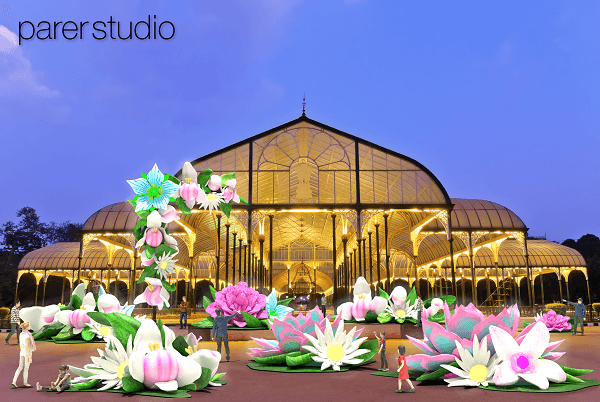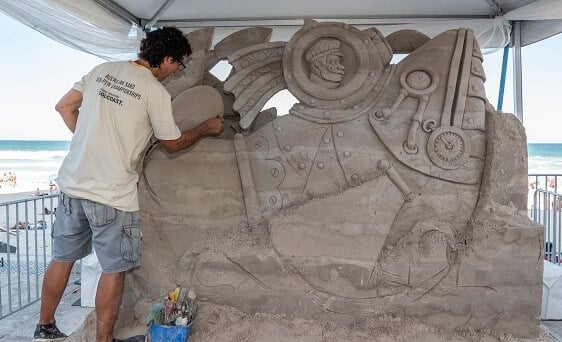Tasmanian-based Australian artist Amanda Parer premieres ‘Lost’ at Beyond the Sand Arts Festival’, a debut illumination, which will grow to great heights on The Esplanade in Surfers Paradise from 13 to 21 March, 10am and 9pm.
Parer has a penchant for making large-scale illuminated inflatables as creative motivation to explore ‘our relationship with the natural world.’ The artist has been captivating audiences across the globe with her larger-than-life installations, which bring bunnies and plants, and humanoids in contemplative poses to life in radiant bursts of luminous colour, light, shape and form.
‘Lost’ is Parer’s largest and most ambitious work to date. It will turn the beachfront into an enchanting botanical wonderland of extinct and endangered floral illuminations.

Often when we speak about the extinct or endangered we go straight to animals, but of course there is a huge amount of botanical species that are also affected. So by enlarging them and selecting pieces that are quite beautiful, and composing them hopefully in a beautiful manner, I want to bring attention to those species as well. All the pieces represented in this work are from all continents around the globe highlighting that it is a global issue.
I spoke with Parer ahead of the Festival’s opening. She reveals insight about her practice and tells us how her magnificent creations come to life.
You began your artistic career in painting and sculpture. How did your practice evolve into the large-scale inflatables you are making today? When I moved from Sydney to Tasmania it allowed me time to explore my themes, and the iconography that I used in my visual art at the time. Then, I was a fine artist working on painting and sculptures and having exhibitions.
Overtime you develop what successfully communicates your ideas to audiences and that for me was toiled Australian landscapes inspired by Tasmania with giant feral animals in them. The animals I used mostly was the rabbit, because at once it is a cute looking animal, but to Australian’s it is also an animal that speaks to us about us introducing feral species. Which is currently out of control and has had a negative effect on our ecosystems here. I like playing with those dualities, they seemed to really resonate with a lot of the viewers that came to galleries, and I really enjoyed having that conversation with them.
A lot of my paintings were large landscapes with large animals in them. I had an idea to play with an installation idea I had, so I was surfing the net and came across the Macy’s Thanksgiving Day Parade in New York where giant inflatables were flowing through the streets. I thought ‘bingo’ that’s a medium I could use to bring the giant animals in my two-dimensional works into the 3-D realm. I went about researching how to do that and China was beginning to open up, so I was collaborating with makers and workshops in China, so that was an interesting journey.
Where do your ideas and inspirations come from?
I went straight to art school from high school, majored in painting and did a bit of sculpture and installation as well. After graduating I recognised, I was a bit green around the gills and I needed to find what would give me passion about creating work in an ongoing manner. I was lucky to be able to travel to the Galapagos Islands with my Uncle who is a natural history filmmaker for the ABC and BBC. He was making a series of films about the Galapagos Islands, the nature and animals there.
I accompanied him for a period of time, it dawned on me how the animals there don’t know man as a threat. They come up to you and are as curious about you, as you are of them. Just having that experience of the natural world made me realise we are having such a profound effect. And so, ‘our relationship with the natural world’ became the basis for the themes in my work.
How do you bring your large-scale installations to realisation, what is the process, and why do you like making large-scale artworks?
When I started art school my paintings were large, but by comparison to what I am making now they are tiny, so I think it’s just been a natural progression that they just keep on getting bigger. I really enjoy mucking around with people’s usual spaces. Places like parks and urban spaces – where people frequent every day and might just walk through them and not take a second glance at their surroundings. If you plonk some giant rabbits or giant growing flowers in there, in places that look like they are just growing in the space naturally, it’s a lot of fun and helps people enter a little fantasy land for a while and to enjoy art in their public spaces.
Tell me about ‘Lost’ how is it coming together?
It’s coming together really well. It’s been on the drawing board for quite a while. But also, with this particular piece I got overwhelmed with choosing which species to use in the piece itself. It is quite overwhelming when you start digging around and you realise how many endangered and extinct botanical species there are.
I had to really force myself to knuckle down and focus on six or seven alone, that was a journey in itself. That’s the creation of the design and the artwork, then you are thinking about the engineering, the mechanics of what will make it work, the lighting to have a successful effect at night, working with technicians and site designers, research and development.
During Covid-19, what were the challenges you faced in the creation of ‘Lost’?
Recent lock down in Melbourne caused some hiccups because our production house is there, that’s been out of bounds. I really welcome people to interact with my work and to touch it. In the past I’ve seen kiss marks on the bunnies and things like that, so there’s been a lot of physical interactions with the pieces which I love because traditionally there is this great big invisible wall between art and people, so I kind of wanted to break through that. In terms of the pandemic, I’ve had to sort of create a barrier, which is unfortunate hopefully that won’t be around us forever.
We are all living day by day and we don’t know when and where another lockdown will happen, so we are learning to function with plan B and possible plan Cs like everyone else. I think it’s just the new normal, for a little while anyway.
What is the message you hope to convey to audiences through the presentation of this work?
I’d like to think my work is multi-layered and if people approach the installation initially and see just beautiful giant flowers and enjoy them in that light, then that’s wonderful. If they take a little time to dig a little further and get to understand the ideas behind the work ‘our connection with the natural world’ that would be my goal, but we have all had a hard time and I’m happy for everyone to just approach the work like Alice in Wonderland, in her giant garden. I think we all need a bit of fun right now.

More about ‘Beyond the Sand Arts Festival’
‘Beyond the Sand’ leaps into Autumn with a lively program of art, music and performance showcasing the creative talent of local, national and international artists. The festival includes the Australian Sand Sculpting Championships, and the colourful Surfers Paradise Beachfront Markets bustling with stalls and food aplenty.
Previously known as ‘Sand Safari Arts Festival’, ‘Beyond the Sand’ carries the legacy of the festival’s former glory into the future with renewed vision taking it far “beyond the heritage of ‘sand and sea’,” emerging to create a new cultural hub reflecting the lifestyle and talent of the Gold Coast’s diverse and energetic art scene. Visit Beyond the Sand Arts Festival to explore the program; which includes sand sculpting workshops, sand activities, circus performances, Dj’s and more. There’s fun for all!